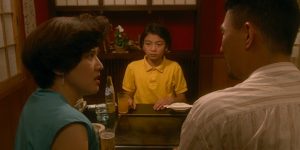
Marty makes ‘em long. His most recent crime opus, Killers of the Flower Moon, based on David Grann’s 2017 nonfiction novel of the same name, explores themes that have long rumbled the conscience of the American auteur: corrosive greed, masculine rot, and the unsettling notion of violence as an accelerant for upward mobility. This time out, he’s dedicated 208 minutes (nearly three and a half hours, only a minute shorter than The Irishman) to telling this version of that story. That’s a full hour longer than Goodfellas, a movie that similarly deconstructed the idea of the American Dream and reframed it through the lens of rugged individualism, sickening violence, and moral decay, with startling clarity and explosive plotting. The result this time around, however, is a narrative that feels hazier in its execution, though no less lurid in its exploration of these enduring themes. By not framing this savage tale from the perspective of the affected indigenous people, Scorsese inadvertently echoes the same indifference he condemns.
In Killers of the Flower Moon, Scorsese’s usual themes occasionally feel cold and indifferent, losing their way amidst the film’s at times impressive, at times exhausting expansiveness. Unlike his previous works that delivered cinematic odysseys with acuity and aplomb, Marty’s signature penchant for riveting crescendos, electrifying performances, and unyielding tension seems to desert him for critical stretches, leaving the proceedings long in the tooth and the performances too steeped in interiority to really burst off the screen. This lack of energy suggests a filmmaker lamenting the horrors of the past with quiet dejected reserve rather than exhuming them for maximum impact. Part of this may be attributed to the decision to focus on antagonists like Ernest Burkhart (Leonardo DiCaprio) and “King” William Hale (Robert DeNiro) rather than the indigenous victims like Lily Gladstone’s Mollie Burkhart.
Scorsese’s film transports audiences to Osage Nation at the turn of the 20th century. The story opens with a sorrowful funeral ceremony, but the Osage people are not mourning a body; they are bidding farewell to their culture, history, and autonomy, symbolized by a peace pipe. The intrusion of the White Man into their land begins a transformation from within. Unlike many other indigenous nations across the USA during the period of Manifest Destiny, the Osage strike it rich when they discover Black Gold—oil, literally gushing from their hills. Scorsese presents an early, powerful image of the Osage people dancing, whooping, and rejoicing, covered in the covetous substance, symbolizing the encroachment of industrialization and foreshadowing the inky-dark perils at bay.
Shortly after their oil discovery, the Osage people found themselves immensely wealthy, each entitled to a share of the oil riches. A title card informs the audience that the Osage had more money per capita than any other group in the country, a birthright that made them prime targets for the nefarious, calloused opportunists like Bill Hale living amongst them. Hale, aided by the dim-witted Ernest, who marries into Mollie’s Osage inheritance, sees the Osage as bridges to be burned on his way to fortune. Thus began the Reign of Terror, a dark chapter in American history characterized by a wave of killings that claimed the lives of over 60 Osage people over the course of little more than a decade.
Scorsese peels back this tragedy through the eyes of its perpetrators, taking us through how Bill and Ernest slowly plotted to cozy up to and then kill those with oil money to their names. Ernest’s transition from hapless war veteran to obedient executioner almost happens offscreen and is without great dramatic upheaval, which makes it somewhat hard to track a man who ostensibly loves his wife but is also willing to execute her entire family and slowly poison her. By framing the film partially as a kind of star-crossed love story, through the lens of Ernest, Scorsese sidelines the pain the character inflicts, pain that we see as quick, inconsequential flashes of violence. These killings were executed as calculated steps to bring King Bill closer to the coveted wealth tied to the land, viewing the elimination of the Osage people, whom he paradoxically considered the “best people on earth” and even close friends, as an unfortunate necessity driven solely by the pursuit of financial gain.
Despite Scorsese‘s efforts to partner with Osage tribal leaders and historians to ensure an accurate representation of their culture and heritage, a significant misstep occurs as he chooses to tell this harrowing story primarily from the perspective of the white criminal, Ernest. By adopting this viewpoint, the film frequently portrays violence against the Osage people as casual and almost routine, as if it were merely a matter of business. While this aligns with the film’s overarching thesis that the murder of innocent Osage people, in the pursuit of wealth by their sinister white neighbors, was strictly professional, it inadvertently results in the sidelining of the Osage victims’ stories and character arcs, granting undue screen time to the killers and leaving a rather unsettling impression.
Lily Gladstone imbues her scenes with a tragic stoicism, though one is left with the impression that she’s just there as a pain sponge. She’s there to absorb the pain of her people, like a cipher for all the indigenous people, stranding her character in the land of the one-dimensional even when her performance has great depth. In Scorsese’s telling of Killers of the Flower Moon, Osage County stands in for America’s entire history with its native people, money-hungry villains wiping its forebears off the face of the earth in order to position themselves one step closer to wealth. Its deepest tragedy found in the utterly cold indifference of its perpetrators.
CONCLUSION: Martin Scorsese’s 208-minute epic about murderous greed in early 20th Century Oklahoma, ‘Killers of the Flower Moon’, is a continuation of his crime epics, this time framing the story against the obliteration of the native Osage population. It’s ultimately a mixed bag of effective but indulgent storytelling, compelling but questionable characterization, and a framing device that begs sympathy for the film’s eponymous villains.
B
For other reviews, interviews, and featured articles, be sure to:
Follow Silver Screen Riot on Facebook
Follow Silver Screen Riot on Twitter
Follow Silver Screen Riot on Instagram
The post Scorsese’s Osage Nation Crime Opus ‘KILLERS OF THE FLOWER MOON’ is a Sprawling Tragedy of American Indifference appeared first on Silver Screen Riot.






